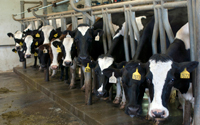It is illegal to sell flesh-eating mammals (i.e., carnivores) other than dogs, cats and ferrets in South Carolina. See Sections 47-5-20 and Section 47-5-50 of the Rabies Control Act.
Some people may keep wild/domestic hybrids, which are animals created through the human-forced crossbreeding of a dog or cat with a wild species, while others keep wild animals confined on their property not as pets, but for other purposes.
Owning wild species is not banned, but keeping wild animals as pets is strongly discouraged. Wild animals do not make good pets as their behavior can be unpredictable, resulting in bites or other injuries to humans. They may also carry diseases that pose a serious threat to human health, including rabies.
Exotic Pets and Animals Taken from the Wild
Unfortunately, there are no approved rabies vaccines for use in exotic pets and wild animals. Additionally, no one knows how long these animals can carry the rabies virus within them before exhibiting symptoms. Per the Centers for Disease Control and Prevention (CDC), in the United States, more than 90% of reported cases of rabies in animals occur in wildlife.
Exotic pets, and animals taken from the wild, such as bats, raccoons, foxes, skunks, bobcats, coyotes, wolves, wolf dogs, weasels, civet cats, spotted skunks, lynx, and bears can carry and become infected with rabies.
If there is ever a chance that an exotic pet or wild animal kept as a pet (including wild/domestic hybrids) attacks or bites a person, DPH officials have the right to enforce Section 47-5-100 of the Rabies Control Act.
Livestock and Rabies

Occasionally, rabid wild animals will enter barns, paddocks, or grazing fields and bite or scratch livestock. Cows are exposed to and infected with rabies more frequently than other types of livestock, although horses, sheep, pigs, and goats also have the ability to become infected.
Rabies Vaccines for Livestock
South Carolina does not require owners of livestock to vaccinate for rabies, although rabies vaccines for cows, horses, and sheep have been approved by the United States Department of Agriculture (USDA).
However, DPH strongly recommends vaccinating:
- Horses, cattle, and sheep that have frequent contact with humans,
- Livestock that are particularly valuable, and
- Animals used for the production, sale, or consumption of their raw milk or raw milk products.
Horses must be vaccinated for rabies before being transported out-of-state.
Symptoms of Rabies in Farm Livestock
Look for unusual behavior:
- Cows typically develop a hoarse bellow. They may drool and swallow abnormally, as though they have something caught in their throat. Some only show depression and weakness, or partial paralysis, of the hindquarters. Hours or days later, the animal will go down, develop convulsive seizures, and die.
- Horses tend to contract the paralytic form of the disease and may initially show abnormal postures with wobbliness of the hindquarters, frequent whinnying, unexplained aggressiveness (with kicking and biting), and signs of colic. They may also show lameness in one leg, followed by an inability to rise the next day.
- Sheep have symptoms similar to cattle, and sometimes vigorously pull their wool. Typically, rabies is seen in more than one sheep in a flock because the animals stay close together and several can be easily bitten at one time.
- Goats with rabies are often aggressive and bleat continuously.
- Pigs with rabies tend to act excited and uncoordinated. Some animals will chew rapidly, salivate, and convulse. Paralysis eventually occurs and death follows in 12 to 48 hours.
If an Animal is Exposed to Rabies
If an animal is suspected or confirmed to have been exposed to a rabid animal, the owner must contact their local public health office immediately. See Section 47-5-80 of the Rabies Control Act.
A DPH public health expert will talk to the owner and investigate the incident. If needed, the DPH investigator will seek guidance with the Public Health Veterinarian and State Veterinarian to determine the safest options for people, pets and other potentially exposed animals.
Handling Tissue from Rabies-Exposed Animals Poses Risks
Handling tissues from animals that may have come in contact with rabies can potentially expose an individual to rabies. The risk depends in part on the site(s) of exposure, amount of virus present, severity of wounds, and whether all the rabies-contaminated tissue is removed before the carcass is handled. The owner should notify anyone who will be handling the animal's body of the possibility of rabies exposure and the need to use infection barriers such as face masks, goggles, double gloves and fluid-resistant clothing or gowns.
Safety of Meat and Milk from Rabies-Exposed Animals
Meat Could Transmit Virus
In animals known to be infected, the rabies virus may be widely distributed in the animal's tissues. Meat and tissue from a known rabid animal should never be used as food for humans or animals.
Eating meat from animals that were exposed to rabies but have not yet shown signs of the disease can also be risky. The level of risk depends in part on where the bite or scratch or wound is located on the animal's body and the severity of those wounds, how much of the rabies virus is present, and whether all contaminated tissue is removed from the animal's body before the carcass is processed.
Federal guidelines for meat inspectors require that any animal known to have been exposed to rabies within 8 months be rejected for slaughter. The owner must notify USDA Food and Inspection Service (FSIS) meat inspectors if an animal was exposed to rabies - before the animal is slaughtered.
Pasteurization of Milk Inactivates Rabies Virus
Heat treatment of milk (a process called pasteurization), inactivates the rabies virus, so drinking pasteurized milk does not expose a person to rabies.
However, raw milk and raw milk products are not heat-treated before consumption, so those products could conceivably carry a risk of rabies transmission from an infected animal. We recommend that animals used for production of raw milk be vaccinated for rabies.

